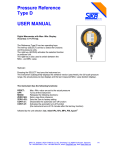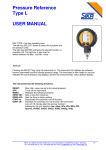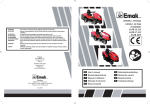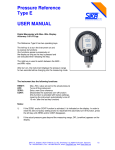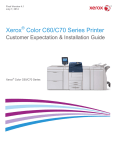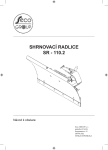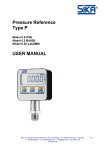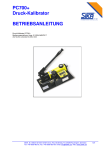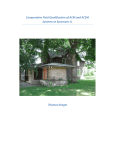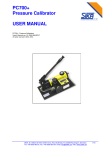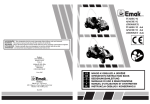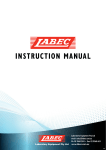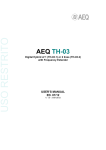Download Hydraulic Pressure Testpump TypeP350 USER MANUAL
Transcript
Hydraulic Pressure Testpump Type P350 USER MANUAL Provides hydraulic pressure of 0 to 350 bar Always release the internal pressure at the connectors before disconnecting. Uncontrolled release of high pressure can result in personal injury and damage to equipment. Excessive pressure can crack or break the fluid reservoir case! Reservoir fluid level: If the fluid level in the reservoir falls considerably during use, a partial vacuum may be created in the reservoir that can affect the performance of the pump. To avoid this, simply allow air to enter the reservoir by partly unscrewing the filling plug. Seal replacement: Depending on the frequency of use, the main piston seal (and others) may need replacing. Replacement seals and instructions for fitting are contained in the seal kit P350 Controls and orientation: JSP Industrial Controls www.jsp.cz JSP, s.r.o., Raisova 547, 506 01 Jičín, Czech Republic Phone: +420 493 760 811, Fax: +420 493 760 820, e-mail: [email protected] SIKA, Dr. Siebert & Kühn GmbH & Co. KG, Struthweg 7-9, 34260 Kaufungen, Germany Tel: +49-5605-803-0, Fax: +49-5605-803-54, email: [email protected], web: www.SIKA.net 1/4 SIKA, Dr. Siebert & Kühn GmbH & Co. KG, Struthweg 7-9, 34260 Kaufungen, Germany Tel: +49-5605-803-0, Fax: +49-5605-803-54, email: [email protected], web: www.SIKA.net 2/4 General notes Test pumps P350 have a small displacement. Minimize the volume to be pressurized. Install a shut-off valve close to the instrument and make your test connection between the valve and instrument. Internal parts of pump are made of Buna-N rubber, aluminum, brass and stainless steel. The pump can be used with oil, water or other compatible fluids. Use of water will accelerate wear of '0' rings and some sticking of piston may result. The recommended fluid is any petroleum based hydraulic ojl, light weight motor oil or mineral oil. Do not use brake fluid or synthetic oils, they may crack the Lexan reservoir or cause swelling or decomposition of the '0' rings. Always keep the pump primed. To prime the pump put a small amount of hydraulic fluid in the reservoir. With the bleed-off valve open squeeze the handle. Fluid should circulate out the bleed-off valve hole back into the reservoir. This may take several squeezes of the handle. If pump will not prime remove the reservoir and .insert a small wire into inlet check valve hole to make sure check valve moves freely. Squirt oil into the inlet check valve while squeezing and releasjng handle. When pump is connected to an instrument and pressurized you will note a slight drop-off'of pressure. This is caused by the natural stretching of the hose. This is temporary and the pressure soon reaches equilibrium. Operation of the P350 Connect hose end to the brass adaptor on the pump. As hose is connected to the adaptor it opens a small check valve in the adaptor. AIways store pump with hose disconected to prevent oil leakage. Connect other end of the hose to the instrument to be calibrated. With bleed-off valve (plastic coated handle opposite the the hoise connection) open, squeeze the handle several. times to make sure fluid is flowing back into the reservoir through the hole above the bleed-off valve. Shut the bleed-off valve. Pump should pressure up. Pressurize to about 3-4 bar (50 psi) below desired pressure. Use fine tuning vernier (noncoated handle facing out the front of the pump) to carefully adjust pressure to desired amount. SIKA, Dr. Siebert & Kühn GmbH & Co. KG, Struthweg 7-9, 34260 Kaufungen, Germany Tel: +49-5605-803-0, Fax: +49-5605-803-54, email: [email protected], web: www.SIKA.net 3/4 Troubleshooting IF PUMP WILL NOT PUMP: It has probably lost it's prime. (See General nortes above). The pump will not pressure up the system unless liquid is first flowing freely back into the reservoir. Dirt under one of the check valves may cause liquid to not flow freely back into the reservoir. Remove, clean and replace check valves. IF PUMP WILL NOT HOLD PRESSURE: It is leaking internally or externally. If leak is not visible externally it may be at one of three place internally (inside reservoir): 1. around brass screw above brass plug, 2. around brass plug or 3. around outlet check valve under brass plug. If pressure goes up when handle is squeezed and drops when handle is released then dirt is under the outlet check valve. Remove brass plug, clean check valve and replace. DO NOT EXCEED the maximum operating pressure indicated on the pump label! Fluid reservoir can crack or break if excess pressure applied. SIKA, Dr. Siebert & Kühn GmbH & Co. KG, Struthweg 7-9, 34260 Kaufungen, Germany Tel: +49-5605-803-0, Fax: +49-5605-803-54, email: [email protected], web: www.SIKA.net 4/4




